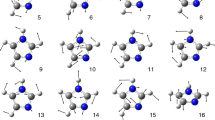Abstract
THE polarographic catalytic waves, observed by Brdička1 in the complexes of cobalt or nickel solutions, are considered to be characteristic of organic molecules containing many active groups. It is accepted, in general, that the —SH group is the most specific for the catalytic process in a cobalt-containing medium, but there are also many other substances which do not contain sulphur in their molecular structure but which form catalytic waves: uric acid2,3, certain amino-acids3 as histidine or lysine, glycerinaldehyde, dihydroxylacetone4 and also ethylenediamine5.
Similar content being viewed by others
References
Brdička, R., Coll. Czechoslov. Chem. Commun., 5, 112 (1933).
Büchner, M., Naturwiss., 43, 1423 (1956).
Březina, M., Advances in Polarography, 933 (Pergamon Press, 1960).
Lamprecht, W., Gudbjarson, S., and Katzlmeier, H., Z. Anal. Chem., 181, 201 (1961).
Marx, H. B., and Schwartz, H. G., J. Electroanal. Chem., 6, 443 (1963).
Author information
Authors and Affiliations
Rights and permissions
About this article
Cite this article
CALUŞARU, A., KŮTA, J. Polarographic Catalytic Properties of Cobalt-nitrohydroxylamine Complex. Nature 207, 750–751 (1965). https://doi.org/10.1038/207750a0
Issue Date:
DOI: https://doi.org/10.1038/207750a0
- Springer Nature Limited
This article is cited by
-
Erzeugung einer katalytischen Doppelwelle
Die Naturwissenschaften (1966)





